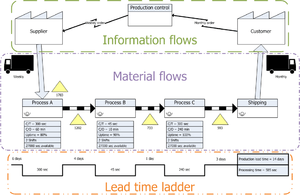Value stream mapping

Value stream mapping is a lean-management method for analyzing the current state and designing a future state for the series of events that take a product or service from its beginning through to the customer. At Toyota, it is known as "material and information flow mapping".[1] It can be applied to nearly any value chain.
Using the Method
- Planning and preparation. Identify the target product family or service. Create a charter, define the problem, set the goals and objectives, and select the mapping team. Socialize the charter with the leadership team.[2]
- Draw while on the shop floor a current state value stream map, which shows the current steps, delays, and information flows required to deliver the target product or service. This may be a production flow (raw materials to consumer) or a design flow (concept to launch). There are 'standard' symbols for representing supply chain entities.
- Assess the current state value stream map in terms of creating flow by eliminating waste.
- Draw a future state value stream map.
- Work toward the future state condition.[3]
Applications
Value stream mapping has supporting methods that are often used in Lean environments to analyze and design flows at the system level (across multiple processes).
Although value stream mapping is often associated with manufacturing, it is also used in logistics, supply chain, service related industries, healthcare,[4][5] software development,[6][7] product development,[8] and administrative and office processes.[9]
In a build-to-the-standard form, Shigeo Shingo[10] suggests that the value-adding steps be drawn across the centre of the map and the non-value-adding steps be represented in vertical lines at right angles to the value stream. Thus, the activities become easily separated into the value stream, which is the focus of one type of attention, and the 'waste' steps, another type. He calls the value stream the process and the non-value streams the operations. The thinking here is that the non-value-adding steps are often preparatory or tidying up to the value-adding step and are closely associated with the person or machine/workstation that executes that value-adding step. Therefore, each vertical line is the 'story' of a person or workstation whilst the horizontal line represents the 'story' of the product being created.
Value stream mapping is a recognised method used as part of Six Sigma methodologies.[11]
Metrics
A key metrics associated with value stream mapping are value adding times and no value adding times.[12] Value adding time is called lead time.
Associated analysis methods
Hines and Rich (1997) defined seven value stream mapping tools[13] they are:
- Process Activity Mapping
- Supply chain responsiveness matrix
- Product Variety Funnel
- Quality filter mapping
- Forrester effect mapping
- Decision point analysis
- Overall Structure Maps
See also
References
- ↑ Rother, Mike; Shook, John (2003). Learning to See: value-stream mapping to create value and eliminate muda. Brookline, MA: Lean Enterprise Institute. ISBN 0-9667843-0-8.
- ↑ Martin, Karen; Osterling, Mike (2013). Value Stream Mapping: How to Visualize Work and Align Leadership for Organizational Transformation. New York, New York: McGraw Hill. p. 4. ISBN 9780071828918.
- ↑ Rother, Mike (2009). Toyota Kata. McGraw-Hill. ISBN 0-07-163523-8.
- ↑ Graban, Mark (2011). Lean Hospitals: Improving Quality, Patient Safety, and Employee Engagement. Boca Raton, FL: CRC Press. ISBN 9781439870433.
- ↑ Graban, Mark; Swartz, Joseph (2011). Healthcare Kaizen: Engaging Front-Line Staff in Sustainable Continuous Improvements. Boca Raton, FL: CRC Press. ISBN 9781439872963.
- ↑ Plenert, Gerhard (2011). Lean Management Principles for Information Technology. Boca Raton, FL: CRC Press. ISBN 9781420078602.
- ↑ Bell, Steven; Orzen, Michael. Lean IT: Enabling and Sustaining Your Lean Transformation. Boca Raton, FL: CRC Press. ISBN 9781439817568.
- ↑ Mascitelli, Ronald (2011). Mastering lean product development: a practical, event-driven process for maximizing speed, profits and quality. Northridge, CA: Technology Perspectives. ISBN 9780966269741.
- ↑ Keyte, Beau; Locher, Drew (2004). The Complete Lean Enterprise: Value Stream Mapping for Administrative and Office Processes. New York: Productivity Press. ISBN 9781563273018.
- ↑ Shingo, Shigeo (1985). A Revolution in Manufacturing: The SMED System. Stamford, CT: Productivity Press. p. 5. ISBN 0915299097.
- ↑ "Value Stream Mapping" Article Source: http://www.isixsigma.com/index.php?option=com_k2&view=itemlist&layout=category&task=category&id=90&Itemid=222#
- ↑ JANUŠKA, M., PÁLKA, P., ŠŮLOVÁ, D., CHODŮR, M. Value chain of virtual enterprise - Possible modern management concepts and value drivers identification. In Annals of DAAAM for 2009 and 20th International DAAAM Symposium "Intelligent Manufacturing and Automation: Focus on Theory, Practice and Education". Vienna: Danube Adria Association for Automation and Manufacturing, DAAAM, 2009. s. 469-470. ISBN 978-3-901509-70-4 , ISSN: 1726-9679
- ↑ Rich, Nick; Esain, Ann; Bateman, Nicola (1997). Lean Evolution: Lessons from the Workplace. Cambridge University Press.
External links
| Wikimedia Commons has media related to Value stream mapping. |